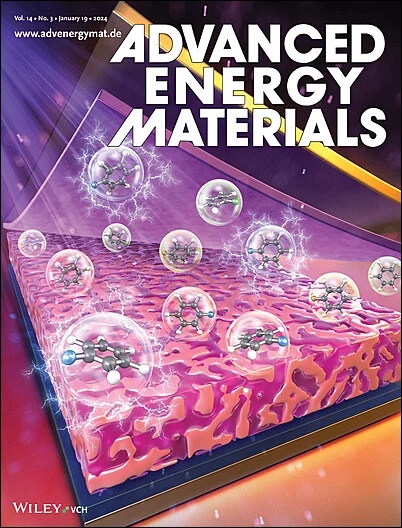Lattice‐Confined Pt‐Ru Dual‐Atom Pair by Space Guard for Robust Hydrogen Evolution with Reversible Hydrogen Spillover
IF 26
1区 材料科学
Q1 CHEMISTRY, PHYSICAL
引用次数: 0
Abstract
Tuning the chemical microenvironment of dual‐atom catalysts is a significant challenge in boosting electrocatalytic hydrogen evolution reaction (HER). Here, a “space guarding” strategy is proposed to precisely place Pt‐Ru dual‐atom pair sites confined in W晶格约束Pt - Ru双原子对在可逆氢溢出条件下的鲁棒氢演化
调整双原子催化剂的化学微环境是促进电催化析氢反应(HER)的一个重大挑战。本文提出了一种“空间保护”策略,利用多金属氧酸盐(POMs) K10[Zn4(H2O)2(PW9O34)2]作为刚性模板,精确地放置限制在W2N晶格中的Pt - Ru双原子对位点。预先保留的局部缺陷捕获了Pt - Ru对位点,并提供了特定的W - Pt - N - Ru配位环境。所得PtRu@W2NDF@NC催化剂表现出优异的性能,在0.5 M H2SO4中具有前所未有的72.7 A mg(Pt+Ru)−1的质量活性,并且在1200小时内具有稳定的电化学HER性能。根据原位拉曼光谱和理论计算的见解,整个析氢途径分为三个步骤:W位点对H2O的吸附速度快,H*和OH*通过其独特的电子流从W位点分别迁移到Pt和Ru位点,Pt位点对H2的解吸效果好。这项工作展示了一种双原子放置策略,通过精确的晶格限制来构建高性能的HER电催化剂。
本文章由计算机程序翻译,如有差异,请以英文原文为准。
求助全文
约1分钟内获得全文
求助全文
来源期刊

Advanced Energy Materials
CHEMISTRY, PHYSICAL-ENERGY & FUELS
CiteScore
41.90
自引率
4.00%
发文量
889
审稿时长
1.4 months
期刊介绍:
Established in 2011, Advanced Energy Materials is an international, interdisciplinary, English-language journal that focuses on materials used in energy harvesting, conversion, and storage. It is regarded as a top-quality journal alongside Advanced Materials, Advanced Functional Materials, and Small.
With a 2022 Impact Factor of 27.8, Advanced Energy Materials is considered a prime source for the best energy-related research. The journal covers a wide range of topics in energy-related research, including organic and inorganic photovoltaics, batteries and supercapacitors, fuel cells, hydrogen generation and storage, thermoelectrics, water splitting and photocatalysis, solar fuels and thermosolar power, magnetocalorics, and piezoelectronics.
The readership of Advanced Energy Materials includes materials scientists, chemists, physicists, and engineers in both academia and industry. The journal is indexed in various databases and collections, such as Advanced Technologies & Aerospace Database, FIZ Karlsruhe, INSPEC (IET), Science Citation Index Expanded, Technology Collection, and Web of Science, among others.
 求助内容:
求助内容: 应助结果提醒方式:
应助结果提醒方式:


